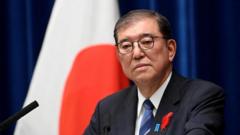In a crucial electoral showdown, Japanese voters are headed to the polls this Sunday as they voice their frustrations over rising living costs and strict international trade policies. Prime Minister Shigeru Ishiba's administration, formed by the ruling Liberal Democratic Party (LDP) and its coalition partner Komeito, is under pressure to secure at least 50 seats in the upper house to maintain its ruling majority. However, many polls suggest that the coalition may not achieve this threshold, heightening the stakes for Ishiba amidst a worsening economic landscape shaped by U.S. tariff threats.
Japan's large automotive sector, which is crucial for employment, is currently burdened by existing tariffs, and disappointing export figures have heightened fears of a potential recession. Ishiba's attempts to negotiate favorable terms with U.S. President Donald Trump, including multiple visits by trade envoys, have yet to yield satisfactory results, leading to public skepticism.
Inflation concerns are impacting daily life, particularly with rice prices nearly doubling over the past year. The government has resorted to utilizing emergency stockpiles to manage food shortages, reflecting the urgent need for economic stabilization. With stagnant wages and persistent inflation demoralizing voters, the LDP's approval ratings have faltered since the last election, where they failed to secure a majority.
The rising popularity of the Sanseito party, which has focused on recruiting younger voters through social media with its "Japanese First" tagline, represents a growing challenge to Ishiba's LDP. The party's hardline positions on immigration and opposition to globalist policies have gained traction among some conservative constituents.
Should Ishiba's coalition fall short of securing 50 necessary seats, it would result in a loss of power in both parliamentary chambers, undermining his leadership and potentially inciting political instability. The LDP's governance, which has persisted almost uninterrupted since 1955, could see significant shifts reminiscent of the 2009 Democratic Party transition of power, which marked a tumultuous political period in Japan.
As electoral results unfold, all eyes will be on Japan's future direction and the implications for its economy and international relations.
Japan's large automotive sector, which is crucial for employment, is currently burdened by existing tariffs, and disappointing export figures have heightened fears of a potential recession. Ishiba's attempts to negotiate favorable terms with U.S. President Donald Trump, including multiple visits by trade envoys, have yet to yield satisfactory results, leading to public skepticism.
Inflation concerns are impacting daily life, particularly with rice prices nearly doubling over the past year. The government has resorted to utilizing emergency stockpiles to manage food shortages, reflecting the urgent need for economic stabilization. With stagnant wages and persistent inflation demoralizing voters, the LDP's approval ratings have faltered since the last election, where they failed to secure a majority.
The rising popularity of the Sanseito party, which has focused on recruiting younger voters through social media with its "Japanese First" tagline, represents a growing challenge to Ishiba's LDP. The party's hardline positions on immigration and opposition to globalist policies have gained traction among some conservative constituents.
Should Ishiba's coalition fall short of securing 50 necessary seats, it would result in a loss of power in both parliamentary chambers, undermining his leadership and potentially inciting political instability. The LDP's governance, which has persisted almost uninterrupted since 1955, could see significant shifts reminiscent of the 2009 Democratic Party transition of power, which marked a tumultuous political period in Japan.
As electoral results unfold, all eyes will be on Japan's future direction and the implications for its economy and international relations.




















